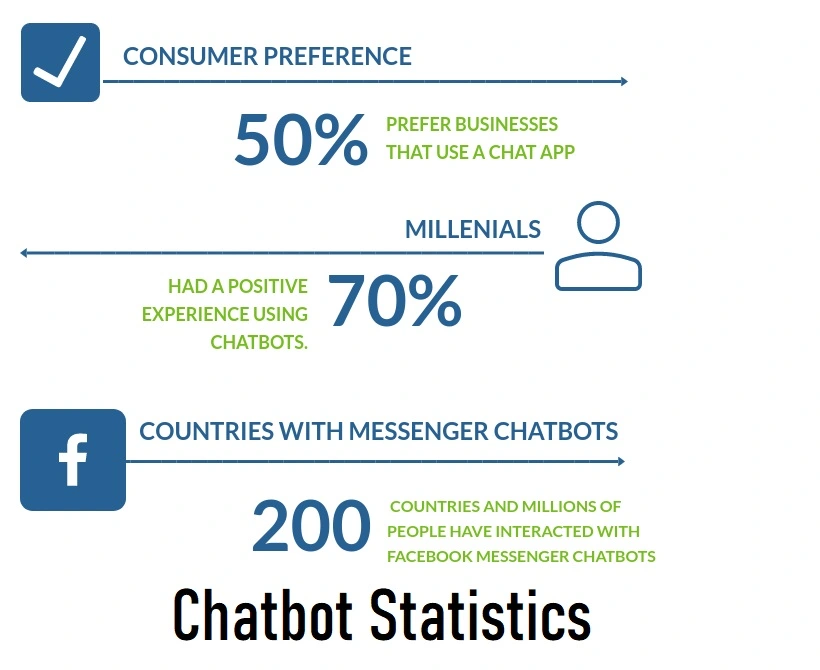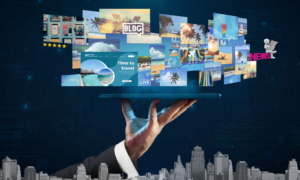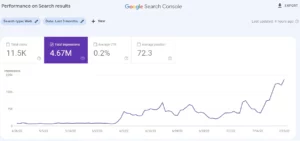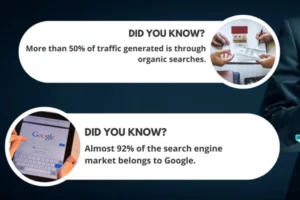Key chatbot research and statistics for 2023: Trends that are shaping the future of businesses
Chatbots are basically computer programs that use artificial intelligence to mimic conversations between humans via text messages. Their key function is to provide assistance and answers to questions that a user might have.
Although chatbots only simulate human to human conversation, the technology is constantly evolving and improving to make the experience as real as possible. Below are some interesting facts about the future of chatbots that everyone should know.
What Consumers Say
Chatbots can create a positive customer experience by providing instant answers and being available 24/7. Below are some statistics on what consumers think about using chatbot technology.
- 62% of consumers would rather engage with a chatbot than have to wait for human assistance to answer their questions.
- 65% of consumers are comfortable talking to a chatbot to handle their small queries.
- Almost 70% of consumers feel that chatbot responses are faster and more instant than human service agents.
- 40% of internet users do not have a preference between a chatbot or human customer service experience, as long as their needs are met.
- Research has shown that 64% of consumers feel that the number one feature of a chatbot service is the 24/7 assistance it provides.
- Over 80% of surveyed consumers say that brand preference depends on whether their queries are handled instantly.
- 23% of people reported that they prefer human to human interactions when it comes to complicated issues such as payment disputes or complaints.
- Over 80% of consumers indicated that they would rate their chatbot experiences as from neutral to positive.
- Almost 60% of customers believe that their outlook on customer service has been changed by using chatbots. Many say that their experiences have been positively affected.
Marketing Statistics of Chatbots
Several industries believe that chatbots are here to stay. As the technology improves, chatbots will start to replace traditional customer service agents in the future.
- 41% of the chatbot market share belongs to North America, where the largest number of chatbot startups are situated.
- It is estimated that the chatbot market revenue will have risen to just over $450 million by the year 2027
- ¼ of companies in the travel and hospitality industry make use of chatbots for general enquiries or online bookings.
- 55% of businesses that participated in research, reported higher quality leads by making use of chatbot applications.
- Research shows that companies can reduce customer service costs by up to 30% when using chatbots.
- The retail industry will benefit the most from chatbot technology in the future. It is estimated that over 70% of retailers will have chatbot applications within the next two years.
- $142 billion is the estimated consumer spend through chatbot services by the year 2024. This is a huge jump from the $2.8 billion in the year 2019.
- Almost 50% of the chatbot market is used by large companies. It is estimated that this number will continue to increase steadily.
- Research shows that chatbots could save companies an estimated 2.5 billion hours
- Over 40% of chatbot technologies are used for sales purposes.
- More than 60% of companies in a recent study believe that chatbot technology will enable them to provide a more customized experience when it comes to their customers.
- The banking industry will be almost 90% automated within the next couple of years.
Chatbot Engagement and Usage
Chatbot usage is on the rise and more and more consumers have noticed chat icons pop up in the lower right hand corner of a website. Below are some interesting facts about the usage and engagement of chatbots.
- 1.4 billion people worldwide are using messaging applications and are willing to engage with chatbots.
- Facebook alone has more than 300 000 active chatbots on its Messenger platform.
- Almost 60% of B2B companies use chatbots on their online platforms compared to only around 40% of B2C companies.
- 40% of millennials use chatbots on a daily basis according to recent surveys done.
- A great chatbot experience can see up to 90% in response rates where low engagement bots can expect a 40% response rate.
- Since 2019, chatbots have grown at a 92% usage rate making it the fastest growing communication channel available.
- IT is the number 1 department in 53% of companies that uses chatbot technology.
- Research in the Insurance industry shows that 83% of users have positive experiences with chatbots.
- Almost 30% of consumers will drop a call when they do not get an instant response for their queries.
- Almost 30% of surveyed consumers were unsure if they were speaking to a chatbot or an actual human.
- More than 40% of companies indicated that AI chatbots are used for voice to text dictation. These intelligent artificial assistants are growing in popularity among larger businesses.
Chatbot Challenges
Chatbot technology is far from perfect, but it is constantly evolving in order to create a more human to human experience. Below are some key concerns that consumers face.
- Almost 50% of users feel that chatbots are in place to prevent them from speaking with actual customer service agents.
- Research has shown that many consumers are concerned that their complex issues can not be resolved by chatbots.
- Some studies have shown that 60% of consumers prefer speaking to an actual service agent. This could be due to the fact that some consumers prefer traditional communication methods.
- 60% of surveyed consumers are concerned that chatbots do not have the ability to understand them.
- Many consumers feel that chatbots provide a “cold” user experience and woud prefer the empathy a real human agent may offer.
- 90% Of users reported a real frustration and felt insulted by the absence of a real human assistant.
Final Words
Chatbots can be an extremely useful resource for business and have the ability to save time and money. They can be used in a variety of different applications and many businesses have already implemented chatbot technology into their customer service experiences.
Although there are still some challenges to overcome, chatbots are becoming more popular and usage is increasing on a daily basis. Engineers are working extremely hard in order to create AI bots that can mimic the human interaction as closely as possible.
Some bots are even able to learn from conversations and adapt according to the needs of the consumer. This will create a more engaging and personalized experience for consumers when they need instant answers to their queries.
Sources and References








